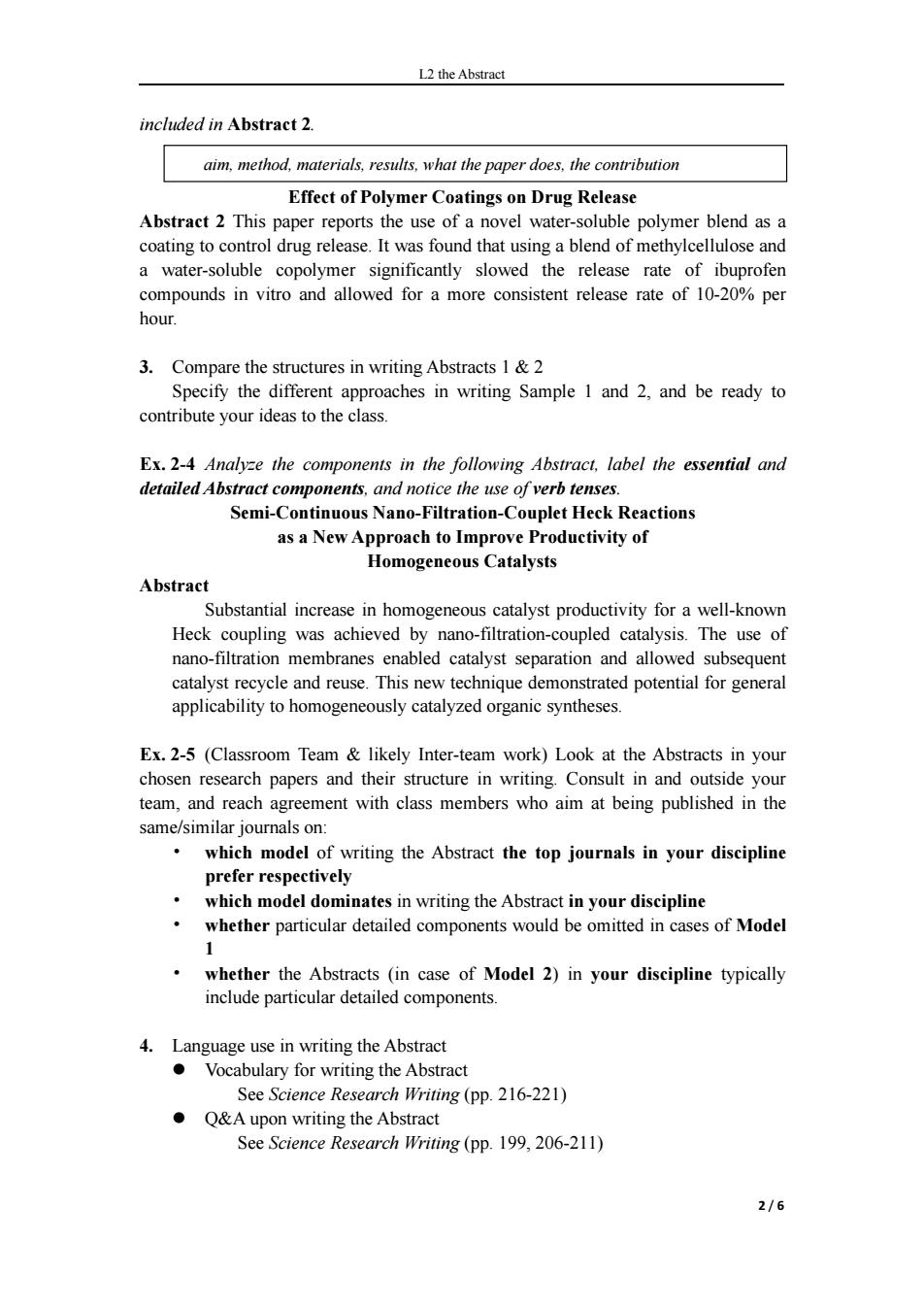正在加载图片...

L2 the Abstract included in Abstract 2. aim,method,materials,results,what the paper does,the contribution Effect of Polymer Coatings on Drug Release Abstract 2 This paper reports the use of a novel water-soluble polymer blend as a coating to control drug release.It was found that using a blend of methylcellulose and a water-soluble copolymer significantly slowed the release rate of ibuprofen compounds in vitro and allowed for a more consistent release rate of 10-20%per hour. 3.Compare the structures in writing Abstracts 1 &2 Specify the different approaches in writing Sample 1 and 2,and be ready to contribute your ideas to the class. Ex.2-4 Analyze the components in the following Abstract,label the essential and detailed Abstract components,and notice the use of verb tenses. Semi-Continuous Nano-Filtration-Couplet Heck Reactions as a New Approach to Improve Productivity of Homogeneous Catalysts Abstract Substantial increase in homogeneous catalyst productivity for a well-known Heck coupling was achieved by nano-filtration-coupled catalysis.The use of nano-filtration membranes enabled catalyst separation and allowed subsequent catalyst recycle and reuse.This new technique demonstrated potential for general applicability to homogeneously catalyzed organic syntheses. Ex.2-5 (Classroom Team likely Inter-team work)Look at the Abstracts in your chosen research papers and their structure in writing.Consult in and outside your team,and reach agreement with class members who aim at being published in the same/similar journals on: which model of writing the Abstract the top journals in your discipline prefer respectively which model dominates in writing the Abstract in your discipline whether particular detailed components would be omitted in cases of Model 1 whether the Abstracts (in case of Model 2)in your discipline typically include particular detailed components. 4.Language use in writing the Abstract Vocabulary for writing the Abstract See Science Research Writing (pp.216-221) Q&A upon writing the Abstract See Science Research Writing (pp.199,206-211) 2/6L2 the Abstract 2 / 6 included in Abstract 2. Effect of Polymer Coatings on Drug Release Abstract 2 This paper reports the use of a novel water-soluble polymer blend as a coating to control drug release. It was found that using a blend of methylcellulose and a water-soluble copolymer significantly slowed the release rate of ibuprofen compounds in vitro and allowed for a more consistent release rate of 10-20% per hour. 3. Compare the structures in writing Abstracts 1 & 2 Specify the different approaches in writing Sample 1 and 2, and be ready to contribute your ideas to the class. Ex. 2-4 Analyze the components in the following Abstract, label the essential and detailed Abstract components, and notice the use of verb tenses. Semi-Continuous Nano-Filtration-Couplet Heck Reactions as a New Approach to Improve Productivity of Homogeneous Catalysts Abstract Substantial increase in homogeneous catalyst productivity for a well-known Heck coupling was achieved by nano-filtration-coupled catalysis. The use of nano-filtration membranes enabled catalyst separation and allowed subsequent catalyst recycle and reuse. This new technique demonstrated potential for general applicability to homogeneously catalyzed organic syntheses. Ex. 2-5 (Classroom Team & likely Inter-team work) Look at the Abstracts in your chosen research papers and their structure in writing. Consult in and outside your team, and reach agreement with class members who aim at being published in the same/similar journals on: • which model of writing the Abstract the top journals in your discipline prefer respectively • which model dominates in writing the Abstract in your discipline • whether particular detailed components would be omitted in cases of Model 1 • whether the Abstracts (in case of Model 2) in your discipline typically include particular detailed components. 4. Language use in writing the Abstract Vocabulary for writing the Abstract See Science Research Writing (pp. 216-221) Q&A upon writing the Abstract See Science Research Writing (pp. 199, 206-211) aim, method, materials, results, what the paper does, the contribution